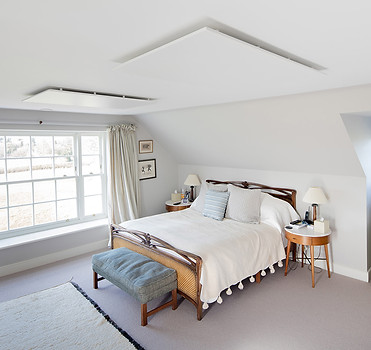Infrared heating
When heat batteries and heat pumps are not viable, infrared heating is the best option to heat a home with electricity. Infrared heating can reduce energy consumption by up to 60% compared to traditional electric radiators, because infrared waves heat objects in the room instead of the air, resulting in more concentrated and efficient heating.
Infrared heating distributes heat more evenly and quickly, which makes it particularly efficient in rooms used intermittently, like guest rooms, utility rooms and bedrooms.
There are two types of infrared heating: panels and a special plastered-in mesh based on an ultrathin film.

1
Infrared ceiling or
wall panels
Ideal for non-invasive retrofits
Cost competitive at £40-60 per sq.m.
2
Ultra-thin film
Ideal for refurbishments: completely invisible
More expensive, costing £120-180 per sqm
Infrared panels are thin and lightweight and can be mounted on walls or ceilings. These panels use a combination of convection and radiation to heat a room, making them an effective heating option.

Plastered-in-infrared, or better ultrathin bonded infrared films are more discreet, as the heating element is invisible. Plastered-in infrared film is ideal in new builds or refurbishments, as it requires installation during construction.
-
For these applications, we recommend contacting EnergyCarbon, which has pioneered the technology in the UK.
Both types of infrared heating offer energy-efficient and effective heating options, and the choice between them will depend on the specific needs and requirements of the homeowner.

